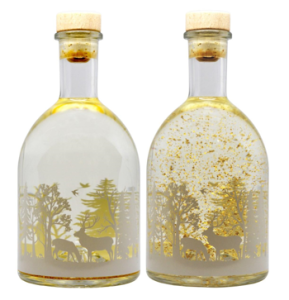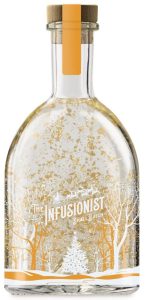The Intellectual Property Enterprise Court (IPEC) has recently decided that Aldi have infringed four registered designs owned by Marks and Spencer (M&S) in relation to light up gin bottles containing gin with an edible gold-leaf. The decision provides a good example of how courts apply the law relating to registered designs and so will be useful for anyone interested in protecting the aesthetic appearance of their products.
M&S own four registered UK designs for light up gin bottles featuring festive decorations and gold flakes which are suspended in the gin when the bottle is shaken. The four designs are numbers 6134278, 6134280, 6134282 and 6134284. Two of the designs are shown below:

In November 2021, Aldi introduced a new product line of gin aimed at the Christmas market and which also included gold flakes in a light up bottle, an example of which is shown below:

M&S alleged that the Aldi bottles was infringing its four registered designs.
A registered design gives its owner the exclusive right to use the design and any design which does not produce on the informed user a different overall impression. So as the bottles were not identical, in determining infringement the court had to decide if the Aldi bottle produced a different “overall impression” or not on an “informed user”.
To do this the court follows the following steps:
This was determined on the basis of the design registration itself and it was not important that M&S only intended to market the product at Christmas. So in this case it identified the relevant sector as spirits and liqueurs in the UK.
In this case, the informed user is an observant purchaser and consumer of spirits and liqueurs in the UK. As they are a consumer, then they have the opportunity to directly compare the products at home. So the fact the bottles are sold in different shops/locations has no bearing on the infringement.
The court decided that the designer had a large degree of freedom in relation to the bottle shape and designs printed on the bottle, but only a small degree of freedom in terms of the gold flakes, as the snow effect was only possible when gold flakes were used.
There was also total freedom to use a light to illuminate the bottle or not, it did not matter that once the light was chosen the only reasonable place to put it was in the base.
Aldi attempted to argue that some features were dictated by technical function, for example the gold flakes had to be used to produce the snow effect. However, the snow effect itself is an aesthetic choice, so the gold flakes were not found to have a technical function.
In determining the overall impression, consideration is given to the design corpus, which encompasses other designs of similar products that predate the registered designs. If the registered design is significantly different from anything in the design corpus, then the overall impression is more striking and the design consequently has a larger scope of protection. Conversely, if the registered design is similar to lots of examples in the design corpus, then its overall impression is more subtle and is restricted to the smaller differences between it and the design corpus.
Any similarities or differences between the registered design and the Aldi products or the design corpus have a cumulative effect when it comes to the overall impression.
The court identified several features that were common between the registered designs and the Aldi products, including:
The court deemed that while the Aldi bottles were slightly different, having regard for available gin bottles in the design corpus, the differences were not sufficient to overcome the similarities.
Therefore, the informed user would not identify the Aldi bottles as producing a different overall impression and the Aldi bottles infringed the M&S design registrations.
This case shows how registered designs can be useful to protect unique aesthetic features of a product. Had M&S not applied to register these designs, it would have been much harder to stop Aldi or recover damages from them. For example, a defence that consumers come to Aldi expecting to buy imitation products is not available for registered design infringement, although is an option for trade mark infringement.
The case is also a reminder that when filing registered designs, it is vital to get the design representations correct. The use of colours, shading and broken or solid lines can all change how a design is protected. It is therefore crucial to obtain advice before filing a registered design application to ensure it will provide the required protection.
Furthermore, the interpretation of infringement is based on the representations protected and not what the applicant is actually producing and selling. So, you should always ensure that registered design protection is updated along with any changes to the appearance of a product. Please contact one of our attorneys for more advice on design rights.